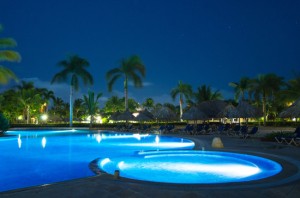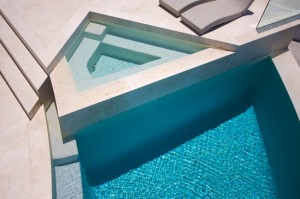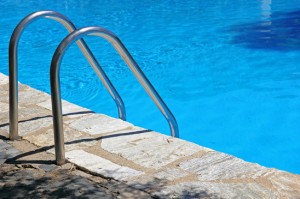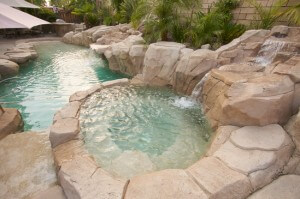
One complete turnover of water every 24 hours provides adequate pool filtering
Swimming pool pumps can be classified by the location of the pump in relation to the water level of the pool: above ground or in ground. Above ground pool pumps are known as a flooded suction pumps. What this means is that the pump is designed to operate with the water level always being higher than the pump.
The opposite is true for in ground pool pumps. They are designed to work with the water level situated lower than the pump. In other words, an in ground pool pump is designed to draw water up — the water level of the pool being lower than the pump. While there are some design differences between the two types of pump, the major difference is in the plumbing.
Pool Pump and Filter Installation
Residential inground and above ground pool pumps are used to circulate and filter swimming pool water in order to maintain water clarity and sanitation. Pools need to be filtered. How long you should filter your pool depends on:
- The size of the pool.
- The filtering equipment.
- How much you use the pool.
- Different environmental factors (such as how much sunlight hits the pool).
As a general rule, one complete turnover of water every 24 hours provides adequate filtering for a single-family pool. The more you use your pool, the more filtering it will need. It is generally recommended that you run your filter for four to six hours a day during the summer and two to four hours a day during the winter.
In houses that have in ground or above ground pool pumps, they are almost always the largest single electrical end-use, using over three times the energy of a new refrigerator. More importantly, they create a diversified electrical demand over 20 times that of a new refrigerator. Residential pump motors range in size from one half to three horsepower (hp), are operated an average of about four hours per day, but in some cases up to 10 hours per day, and draw approximately one kW per nominal horsepower.
A leaf strainer is usually integrated and aids in priming the pump when it is installed higher than the pool surface. Pools may use multiple pumps for pool filtration, bottom cleaning (pool sweep), and for operating water jets for adjoining spas. Bottom cleaning systems are usually integrated with the filtration systems and operate on vacuum or pressure supplied by the filter pump. They either operate on the suction side (vacuum) of the filtration piping (such as the bottom crawler type), or on the high pressure side of the pump (such as floating pool sweeps). Since bottom cleaning (“pool sweep”) systems require full flow to operate properly, low speed operation of two-speed pumps can inhibit their function. High-pressure cleaning systems sometimes employ separate pumps to provide water pressure, but this practice is becoming less common.
Three types of filter media are commonly used. Sand filters remove particles down to 25 microns (μ or micrometers) and are cleaned by back washing. Cartridge filters remove particles down to approximately 15μ and are cleaned by removing the cartridge and spraying it down. Diatomaceous earth (DE) filters remove particles down to 3μ and can also be back-washed (ADM 2001). Sand filters require the most pump pressure, followed by diatomaceous earth and cartridge filters.
Selecting an above ground pool pump or an inground pool pump
Manufacturers offer high efficiency pump-motor combinations for most of their product lines, typically using capacitor start, capacitor run motors, but specific pump efficiency data are not generally published by manufacturers and are not available from other sources. Manufacturers offer above ground and inground pool pumps with the following characteristics:
A) Single-speed Pump: A pump which has an electric motor that operates at only one speed.
B) Multi-speed Pump: A pump which has an electric motor that can operate at multiple, discrete speeds.
C) Variable-speed Pump: A pump which has an electric motor that can operate at continuously variable speeds.
D) Variable-flow Pump: a pump which has an electric motor that can operate at continuously variable speeds, with added controls that automatically adjusts speed to control flow.
Selecting a pump entails picking the pump with the right characteristics that fit the design requirements of the pool and evaluating the performance parameters published by the manufacturer. Most manufacturers provide the following information about the pump-motor:
- Rated HP
- Actual HP
- Service Factor
- Volts
- Amp Draw
- Energy Use (watts)
- Annual Cost @ 24 hr filtration
- Annual cost @ 12 hr filtration
- Pump Warranty
- ROI (5 year)
- Energy Efficiency Rating
- Overall Product Rating
It is important to understand what each of these performance parameters mean in determining the right pump for you. The following is an explanation of the terms listed above:
- Rated Horsepower (HP): The motor power output designed by the manufacturer for rated revolutions per minute (RPM), voltage and frequency. May be less than Total Horsepower where the Service Factor is > 1.0, or equal to Total Horsepower where the Service Factor = 1.0. Also known as Nameplate Horsepower.
- Service Factor: A multiplier applied to Rated Horsepower of a motor to indicate the percent above Nameplate Horsepower at which a pump motor may operate continuously without exceeding its allowable insulation class temperature limit, provided the other design parameters such as rated voltage, frequency and ambient temperature are within limits. A 1.5 HP pump with a 1.65 service factor produces 2.475 HP (Total Horsepower) at the maximum Service Factor point.
- Total Horsepower: The product of the Rated Horsepower and the Service Factor of a motor used on a Pool Pump (also known as Service Factor horsepower, SFHP) based on the maximum continuous duty motor power output rating allowable for nameplate ambient rating and motor insulation class. Total Horsepower = Rated Horsepower x Service Factor.
- Volts/Amps/Watts –The energy efficiency of a pump is measured by the electrical consumption of the pump and motor and is dependent on the Amps and Watts.
- ROI – Return on Investment & Energy Efficiency are both linked and determine the selection of the pump
- Overall Product Rating is very important – review about the pump by experts, by consumers and by agencies that test equipment should be reviewed before deciding on a specific pump.
The following pump makes are currently available in the market with energy efficiency ratings that can qualify for rebates from your local electric company.
- Leaf Pumps
- Eco Pump
- Pentair Intelliflo
- Hayward Tristar
- Pentair Whisperflo
- Hayward Northstar
- Sta-Rite Max-E-Pro
- Hayward Super 2



